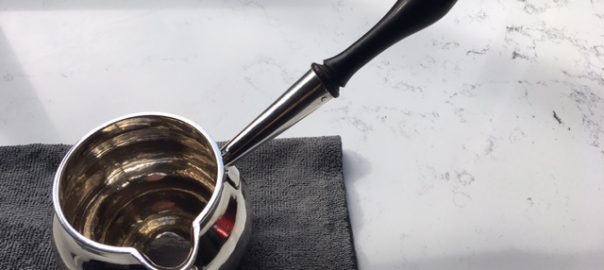Antique Georgian Solid silver large brandy saucepan, crafted by Thomas Tearle, London c1730




18/06/2013
After nearly 300 years, all the marks are likely to have been rubbed and lost clarity. I bought a TT bowl several years ago and had difficulty making out the marks. We just have to trust the sellers – OK if they are gold or silversmiths.
congratulations again
Barbara

23/08/2013
Dear Barbara, Richard
Did you see the Antiques Roadshow this week?
There was a questions about fake silverware, and the fake was real silver and actually manufactured by the person who had stamped it. However, in 1720, there was a tax applied to all silverware and a few silversmiths tried to get around the tax by selling the silverware without getting it assayed by the agent (I forget their name, something like the Goldsmiths Guild) in London. This means the silverware can never be sold and is actually valueless. It must be taken to the asayers office in London, who will stamp it with the actual date of the assay, and THEN the item is “legal” and can be sold.
I told you that on the bottom of the Thomas Tearle brandy warmer I have are four makers marks, and no other. I expected to see the London mark and the date, but there’s none.
Do you think I should take the item to London and get it legally assayed?
Regards
Ewart
24/08/2013
Dear Ewart
Yes, I did see the Antiques Roadshow and took especially interest in the item on silver. I had hoped that they would say who the other three pieces were made by, as any of them could easily have been TT’s.
FYI – the assay office in Goldsmiths Hall which is the HQ of the Goldsmiths’ livery company. It is very near the Guildhall.
Such a pity that your TT brandy warmer only has the marker’s marks. I must check my piece too.
You should certainly consider taking the brandy warmer for assaying. See http://www.thegoldsmiths.co.uk/welcome-to-the-assay-office/ and especially the pdf called Hallmarking Guidance notes under the section Hallmarking about two thirds of the way down this page. It recognises that there are unhallmarked items, but does not specifically deal with what to do. After Antiques Roadshow, they will no doubt be inundated by people requesting retrospective hallmarking and could well do with producing a leaflet on it.
Maybe you should start by emailing them and asking what to do
Best wishes
Barbara
24/08/2013
Thanks for the information Barbara
The pdf you mention below is very interesting; I’ll contact the Goldsmiths’ Company and see what I’m advised to do.
I looked carefully at the marks on the four items on the Antiques Roadshow and didn’t see the TT mark. It’s quite distinctive, so I don’t think any of the articles were made by Thomas
I’ll get back to you once I have a response from the Goldsmith’s Company
Regards
Ewart
29/08/2013
Evening Barbara
Elaine and I had a delightful day in London. We phoned the Goldsmith’s Hall and asked if we could talk to somebody about the Thomas Tearle brandy warmer. The receptionist said that we should speak to Dave Merry, head of the Assay Office training. He would be waiting for us, would we please go to the Gutter’s Lane entrance. When we arrived there Dave met us shortly after we introduced ourselves to security. He took a close look at the maker’s marks on the bottom of the brandy warmer, noted with some surprise the excellent condition of the piece and noted that he thought that it was a TT, but he would take it to another room where the light was better and show it to his boss. When we came back after the closer inspection both he and his boss though that it was genuine. He also thought the makers mark without a hallmark were because the pot was made specifically for a wealthy purchaser, and neither he nor Thomas wanted to pay the post – 1720 tax. He suggested we ask an expert about the armorial mark on the front of the pot because it might point to the original purchaser. He also suggested that we leave the pot with him to assay it so that he could send us a certificate of authenticity, especially in regards to the period in which it was made.
[He warned us that if the brandy warmer was not a genuine TT, we would lose the pot and we are not going to be given our money back. We swallowed that and said yes please, we still wanted it done.]He then showed us around the Goldsmiths’ Hall and outlined a little of its history and aims. He has also just sent us an invitation to the next Goldsmiths Fair. He then took us to the Goldsmiths’ Hall Library where the librarian (“Ooh, it’s nice and heavy isn’t it she said hefting the pot”) showed us documents relating to Thomas’ life and work including the three makers marks he was required to register over the time of his working life. Those documents showed us Thomas worked in Foster’s Lane, so the St Vedast Church was his local and nearest. Later he moved to Covent Garden. She also showed us the apprentices he employed. His second was a James Fossey and I wonder if he came from Stanbridge. The other names are not those I recognise amoungst the Tearle valley families. As we left the Goldsmiths Hall we dropped into the St Vedast Church and lit a candle for him and his family.
I took Elaine to the London silver vaults in Chancery Lane and the owner of Koopman Rare Art (Timo) who sold John L Tearle his TT and instantly recognised us, showed us around his new stock. He said when we received the pot back from the Goldsmiths Hall, we could bring him the piece and he would see if he could recognise the Armorial mark on the front, and he would give us an informal valuation of the pot. He also said, in common with Dave Merry, that he used his silver brandy warmer to warm brandy at Christmas time.
So that is a very promising start.
Regards
Ewart

01/09/2013
Dear Ewart
This is a fascinating piece of real background about how people worked, and especially, worked around the rules. You must have been extremely pleased with your day, not only for the information about TT, but also the extras – Goldsmiths Hall Library and the silver vaults.
The apprentice in 1724/5 was John Fossey, son of Daniel Fossey, draper, deceased, of Hempstead (presumably Hemel Hempstead). Other apprentices were Charles Martin, son of William Martin of Wrenbury, Chester in 1722. Lygoe Scarborough, son of John Scarborough of Woburn, Beds in 1726. Robert Grey, son of Martin Grey of Hempstead, Herts, in 1731/2. John Scarborough son of John of Woburn, Beds in 1733. William Sheppard of St Mary Le Strand in 1737. William Partridge, son of James Partridge, of Watford also in 1737. John Jennings of London in 1740.
Several of these apprentices were turned over to TT – ie their apprentices transferred from a previous master possibly because he had died.
The majority of apprentices TT chose were from Beds or from Herts, so he managed his contact with home.
TT lived for a good many years in Stone Court, which is off Gutter Lane, near Foster Lane.
I’ve looked at my TT piece a loving cup of 1733 it has the regular set of marks, although several are well rubbed. No armorial bearings. It would be good to know whose armorials are on your piece. If it can be identified as someone or a family who were active in the early 1700s and might have commissioned the piece then we would be making a start on identifying his clientele.
This is fun!
Best wishes
Barbara


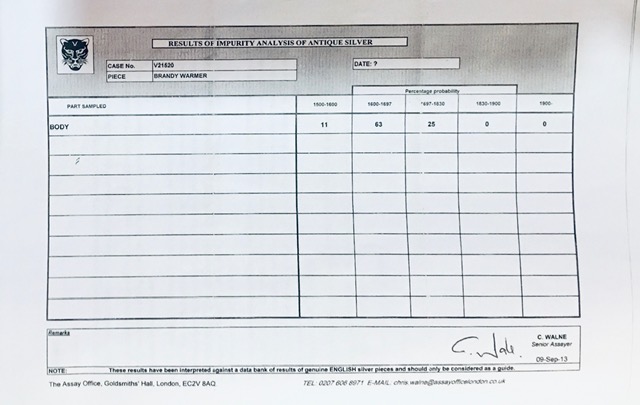
15/09/2013
Dear Barbara
Elaine went to London on Friday to pick up the TT brandy warmer after we had received an email from the Goldsmiths Hall to pick up the pot after the Assay. The results were very pleasing.
I have attached the Goldsmiths Hall Assay Report, and what it means is that column 1600-1697 at 63|% and the column 1697-1830 at 25% add up to a certainty that the object was produced in the time period of Thomas Tearle’s work.
After her visit to the Goldsmiths Hall, Elaine went around to see Timo Koopman at Koopman Rare Art in the London Silver Vaults Building, and she had a fascinating conversation with him. He said that the report says that the piece falls strongly in the time period that Thomas Tearle was working in, and that all the indications are that object is indeed a TT, and was made in the Hugenot style typical of the period. He said the whole design of the pot was Hugenot style and pointed to the teardrop spout as a very common feature.
Timo also pointed out that the Arthur G Grimwade has Thomas’ mark(no: 2938) clearly within the time period 13.06.1720 to 22.06.1739 and this is how the assay is pointing. Thomas has purchased “old” silver because it was higher quality than 925 sterling, and possibly melted it down then to produce this pot. The armorial pattern on the front is a “wave pattern with ducal crown”, but he was unable to suggest a family who might have used it. He said that the pot was of good weight, well made, and something that we should be proud of.
He reiterated that we should use it at Christmas time for the purpose that Thomas intended.
“What’s the point,” he said “in having something posh and never using it? It is a beautiful brandy warmer and it should be used.”
We really do have a Thomas Tearle
Kindest regards
Ewart
TT brandy warmer
28/09/2013
Evening Barbara, Richard
There is a wee codicil to this story.
We went to the Goldsmiths Hall for their 2013 event yesterday and met Dave Merry again, who explained that our Thomas Tearle was not subject to any law with regards to its reselling because it was made before 1950. He was delighted that our TT was genuine, and he listened intently to what Elaine told him about her conversation with Timo.
“Was that Thomas Tearle brandy warmer yours?” We turned around to face a pretty brunette, young, short, with a diffident air, probably the result of her junior status in such an august building. “I prepared that for the assay, I’m so pleased that it turned out to be genuine.”
Her green eyes dropped their focus to the floor and she smiled shyly. “You did us an excellent service” Elaine said “your work was so good we couldn’t find the place on the pot where you collected the sample.”
“We try to cover up the scar,” Dave Merry said, he looked at his young apprentice. She blushed.
“I never saw the results of the assay” she said, “I seldom do, so I’m really pleased it worked out for you.” Her white blouse had the London Goldsmiths logo in the form of an embroidered patch with gold stitching on a black background. Her name badge said Candice Devine. Elaine turned to talk to Dave Merry again, and Candice turned to look at me.
“I’m learning how to stamp silver objects with the London marks” she said. Along the back of the bench that she was standing at were a row of of stamping dies that I was familiar with from my early days working on a printing press, but much smaller than the dies were two rows of little shapes I had never seen before. She showed me one of the stamps and then hovered the small end over a square of 15mm aluminium plate. She hit the end of the die with a deft strike, accompanied by a brisk pinging sound and then raised the die. There on metal was a perfect mark of the London Leopard.
“It’s different for shaped objects like a ring where you have to stamp it, but of course you can’t flatten the ring.” She reached for one of the small shapes in front of the dies and dropped it into a hole in a larger steel vice. She held the ring and positioned it in a low, curved depression in the little tool that I hadn’t noticed before. She took up the die from the rack and tapped it into the inside of the ring. She took the ring from the tool.
“There you are” she said. She sloped the inside of the ring towards me so that I could see her work. “The curve in the negative must match the outside shape of the object you are going to make the mark onto.” She gave me an eyeglass and I could see how clearly and with what craftsmanship the ring had been marked.
I looked directly at her and shook my head slightly in approval. “My dad made model steam engines on a 4 inch lathe, and he made all his own tools. They were mounted in wooden blocks just like yours, and they formed rows of little objects just like yours do.” I waved my hand over the collection of tools – tallest at the back, most used on the left, and they are the sign of a craftsman and enthusiast.
“I love this job” with a wide and winning smile, “I am so lucky to have it, and I have still have so much to learn”.
Dave Merry joined us, his black suit shining with gold thread and his white unruly hair underlined with bright blue eyes enclosed by circles of horn rimmed spectacles. I mentioned that TT had his workshop in Gutter Court – and Dave Merry said that he knew the place. It was little more than a small indent in Gutter Lane and in the 1970s there was a tiny pub called the Hole in the Wall. It was so small there was room for one table for 4, and a tiny bar with room for 1 worker behind it surrounded by shelves of the pubs stock. He doesn’t know when it was filled in by a new building, but Gutter Court doesn’t exist anymore.
I hope you like that
Ewart
info@koopman
My name is Ewart Tearle and I am contacting you from New Zealand. I spoke briefly to Lewis by telephone on this matter tonight:
I own a Thomas Tearle brandy warmer which I purchased while living in the UK. I have a current valuation from the UK Assay Office in London showing me that my item is genuine which I commissioned in person while living in the UK.
The warmer is currently missing a rivet to the handle. The rivet on the back of the handle is made by Thomas Tearle but the front rivet is missing and was missing when I purchased the item. It would appear that the Assay office has marked the area next to that missing rivet while conducting their valuation and report. If I arrange for a local jeweller here in New Zealand to replace that missing rivet, will it invalidate my documentation from the Assay Office or affect its valuation? Please can you advise me?
I enclose a set of photographs of the item concerned.
Yours sincerely
Ewart Tearle
Photo 1: shows the full warmer with the missing rivet. The rosewood handle rattles alarmingly when I move the warmer or pick it up. In this view the missing rivet is clearly shown.

Photo 2: shows where the missing rivet should be

Photo 3: shows where the existing pin/rivet is holding the rosewood handle into the neck of the silver arm

Photo 4: shows the close-up of the good side of the rivet

Dear Mr Tearle,
Thank you for your full explanation and detailed images. With sympathetic restoration, the price for this piece will not be affected. The ruling is that such a small piece of silver is well within the boundaries of the Goldsmiths Hall and will actually prevent any further damage when used in its current state. There is no change of use either which is another criteria considered when undertaking restoration.
A small tapered pin will do the job. I hope this makes you feel more at ease but do feel free to reach us if you have any further reservations.
Yours sincerely,
Timo Koopman
Koopman Rare Art
53-64 Chancery Lane London,
WC2A 1QS
+44 (0) 207 242 7624
Thank you, very much Timo.
The care and concern you have offered me has been deeply appreciated.
On the day we received the documentation from you, Elaine (my wife) and I went to see you in Chancery Lane. We were very excited that the warmer had passed all the necessary requirements. We were then shown around the Koopman Rare Art by (I think you, Timo and Lewis) and we were shown all of the beautiful articles in the Rare Art room. We were nobody off the street, but you were so kind.
We contacted you first because of your kindness, and your deep knowledge of rare art works. We were correct to do so.
If you wish, you can see the essay I wrote of our adventure, on:
www.tearle.org.uk
Kindest wishes
Ewart and Elaine Tearle
The Thomas Tearle brandy warmer was repaired by Damin Moys, DM Jewellery Design, of Otorohanga, New Zealand.
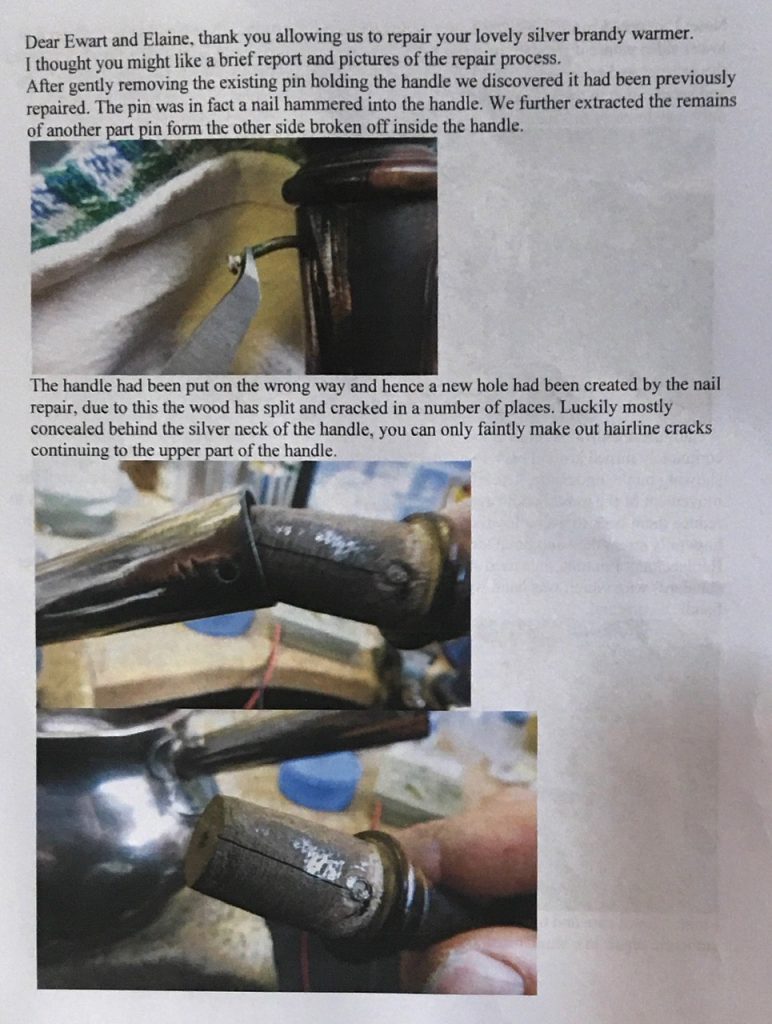
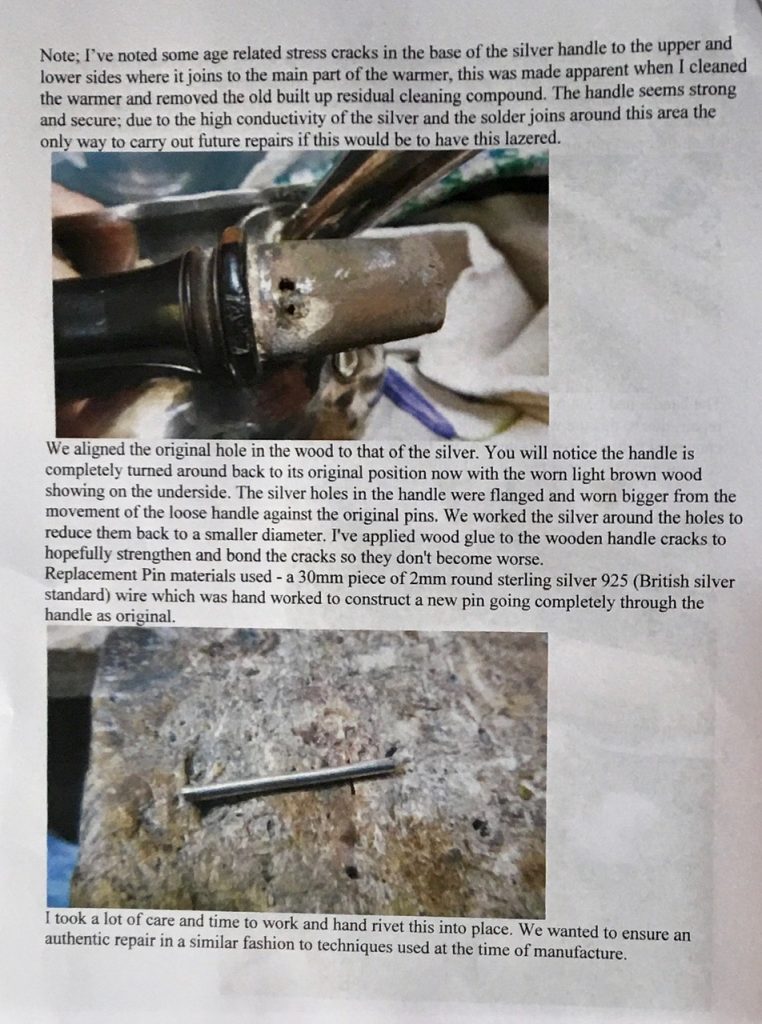
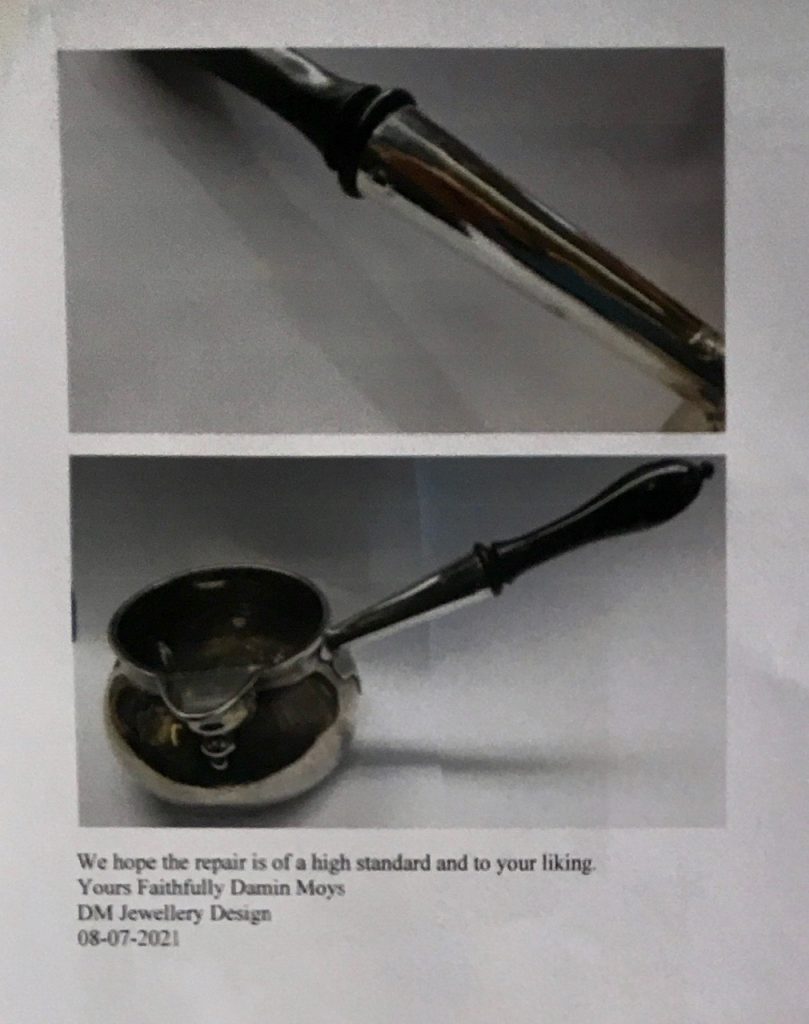
How to keep your silver treasures in tip-top order.
Damin’s Method:
1 Part-fill a glass bowl with with boiling water.
2 Add 1 tbsp washing soda crystals. Leave to dissolve.
3 Drop a piece of aluminium into the bottom of the bowl.
4 Dip the piece of your silver into the solution, letting it touch the aluminium, but don’t let it touch non-silver items.
5. Rinse in warm water.
6. Dry off with a soft tea towel to remove any washing soda residue.
7. Give a final wipe over with a silver polishing cloth.
Note: This method can be used to clean any solid silverware. It is not recommended for silver plate.
